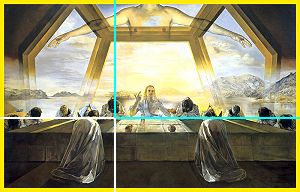As a science major I have been dealing with mathematics a lot. Through the study of mathematics, I was often struck by the beauty and elegance of mathematics. In math, order somehow manifests out of apparent chaos and creates patterns and symmetries.
 |
| Although π is an irrational number, its visualization using a software called CIRCOS showed emerging patterns. https://www.visualnews.com/2013/07/09/the-art-of-pi-a-colorful-data-visualization/ |
I always believed that science is under great influence of mathematics and now I believe that art is greatly influenced by math as well. Mathematics becomes a great tool for artists to convey proportion, one of the 3 principal parts of painting according to Piero Della Francesca. Francesca’s work on mathematics and geometry contributes greatly to De Divina Proportione, a book by Luca Pacioli detailing the application of mathematical proportions to visual arts. In this way, mathematics helps artists to create more realistic works.
 |
| The study of the proportions of human https://en.wikipedia.org/wiki/De_divina_proportione#/media/File:Divina_proportione.png |
One of the most well known proportion is no doubt the golden ratio. Some say that this proportion yield pleasing and harmonious perceptions. In geometry, the golden spiral is a logarithmic spiral that has the growth factor as the golden ratio. It could be found in nature from something as small as a nautilus and as big as the spinning arms of spiral galaxies; a great example of the mysterious connection between math and nature. Golden ratio has been subtly applied to many architectures and artworks as well. For example, Salvador Dali's work "The Sacrament of the Last Supper" itself is a golden rectangle and the dodecahedron in the background also exhibit golden ratio relationships.
 |
| Golden ratio in “The Sacrament of the Last Supper” by Salvador Dali |
The artwork utilizing fractals by Pollock has also caught my eye. Fractals basically means a single shape repeated at different magnification thousands of times. It is essentially what Pollock's drip painting constitute of. What really caught my interest is that a physicist Richard Taylor built a machine to create similar kind of paintings. However, the physicist remarked that "no machine, no matter how clever, can ever replace the human eye when it comes to aesthetic judgments".
 |
| Pollack's Fractals |
Sources:
Caridad, Paul. "The Art of Pi - A Colorful Data Visualization." Visual News. N.p., 09 July 2013. Web. 26 June 2016. <https://www.visualnews.com/2013/07/09/the-art-of-pi-a-colorful-data-visualization/>
"De Divina Proportione." Wikipedia. Wikimedia Foundation, n.d. Web. 26 June 2016. <https://en.wikipedia.org/wiki/De_divina_proportione>
Meisner, Gary. "Golden Ratio in Art Composition and Design." The Golden Ratio Phi 1618. N.p., 04 May 2014. Web. 26 June 2016. <http://www.goldennumber.net/art-composition-design/>
Ouellette, Jennifer. "Pollock's Fractals." Discover Magazine. N.p., 1 Nov. 2001. Web. 26 June 2016. <http://discovermagazine.com/2001/nov/featpollock>
Vesna, Victoria. “Math + Art.” Lecture.
Ouellette, Jennifer. "Pollock's Fractals." Discover Magazine. N.p., 1 Nov. 2001. Web. 26 June 2016. <http://discovermagazine.com/2001/nov/featpollock>
Vesna, Victoria. “Math + Art.” Lecture.


